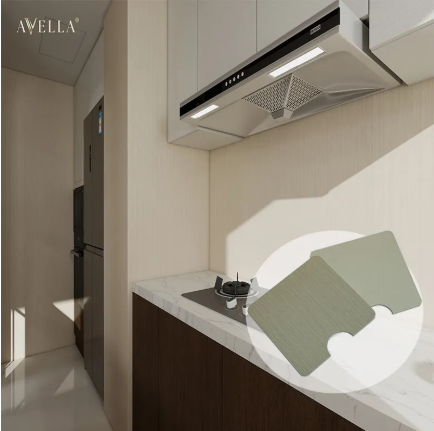ပြင်းထန်သော အရောင်းအဝယ်မရှိသော အခြေခံအချက်များနှင့် ဖွဲ့စည်းပုံများ
ကြွက်-ပလာစ်တစ် ရုံးအလေးချိန်တွင် အမြဲတမ်းသော အမြဲတမ်းများ
SPC နံရံပြားများသည် အဘယ်ကြောင့် ခိုင်မာသနည်း။ သူတို့၏ လျို့ဝှက်ချက်မှာ သူတို့၏ ဦးတည်ချက်တွင်ရှိသော ကျောက်-ပလပ်စတစ်ပေါင်းစပ်ပြားအတွင်းပိုင်းကြောင့် ဖြစ်ပါသည်။ ဤရောစပ်မှုသည် သဘာဝကျောက်ခဲများကို PVC နှင့် ရောစပ်ထားခြင်းကြောင့် ယနေ့စျေးကွင်းတွင်ရရှိနိုင်သော ပုံမှန်ပစ္စည်းများနှင့် နှိုင်းယှဉ်ပါက ဤပြားများအား အမှန်တကယ်ခံနိုင်ရည်ရှိစေပါသည်။ ရလဒ်အနေဖြင့် အဘယ်သူမျှ ပုံစံပျက်ခြင်း သို့မဟုတ် အချိန်ကြာလာသည်နှင့်အမျှ ပုံစံကွဲခြင်းမရှိဘဲ ဖိအားကိုခံနိုင်သော ပြားများကိုရရှိစေပါသည်။ ထို့အပြင် ကျောက်ခဲများဖြစ်သော ကျောက် lime များကဲ့သို့ အစိတ်အပိုင်းများပါဝင်မှုကြောင့် ဤပြားများသည် အလေးချိန်ကိုလည်း ကောင်းစွာခံနိုင်ပါသည်။ နှစ်ပေါင်းများစွာအသုံးပြုပြီးနောက်တွင်ပင် ကွဲပြားခြင်း သို့မဟုတ် ကျိုးပဲ့ခြင်းကို စိုးရိမ်စရာမလိုပါ။ ထို့ကြောင့် တည်ဆောက်သူများနှင့် အိမ်ပိုင်ရှင်များသည် အခက်အခဲများကို ကျော်လွှားနိုင်သော အရာဝတ္ထုတစ်ခုကို ရှာဖွေတိုင်း SPC နံရံပြားများကို ပြန်လည်ရွေးချယ်လေ့ရှိကြပါသည်။
အလျော့များ၊ ကျောက်ပြားများနှင့် ထိခိုက်မှုများအား ကာကွယ်ပေးသည်
SPC Wall Panels သည် အများအားဖြင့် နှိပ်မှု၊ ခြစ်မှုနှင့် ထိခိုက်မှုများကို ခံနိုင်ရည်ရှိပြီး လူများသည် နံရံများကို မကြာခဏ ထိမှုများရှိသော နေရာများတွင် အသုံးပြုရန် သင့်လျော်ပါသည်။ နံရံပြားများသည် နေ့စဉ်အသုံးပြုမှုကြောင့် ပျက်စီးမှုများကို ခံနိုင်ပြီး အနမ်းအသွေးဖြစ်သော်လည်း အဆင်ပြေစွာ အသွင်အပြင်ကောင်းကောင်းဖြင့် ရှိနေပါသည်။ ဓာတ်ခွဲခန်းစမ်းသပ်မှုများကလည်း အထောက်အပံ့ပေးပါသည်။ နောက်ပိုင်းစမ်းသပ်မှုတစ်ခုတွင် ပြင်းထန်သောအရာများမှ ထိခိုက်မှုများကို ခံရသော်လည်း နံရံပြားများသည် အသစ်ကဲ့သို့ပင် အသွင်အပြင်ကောင်းကောင်းဖြင့် ရှိနေခဲ့ပြီး ပုံမှန်သော နံရံပြားများသည် အလားတူ အခြေအနများတွင် ပျက်စီးသွားမည်ဖြစ်ပါသည်။ အဆောက်အဦပိုင်ရှင်များအတွက် ကုန်ကျစရိတ်ကို ခြွေတာပေးနိုင်သောကြောင့် ပျက်စီးသွားသော နံရံပိုင်းများကို အစားထိုးရန် မလိုအပ်တော့ဘဲ နံရံတစ်ခုပြီးတစ်ခု ပြုပြင်ရန် အချိန်များကို မကုန်ဆုံးတော့ပါ။
ရေပျားခြင်းရှိသော ဒေသများအတွက် အတည်ပြုထားသော အားပေးခြင်း အကျိုးအရှိန်
SPC Wall Panels က ရေစိုထိုင်းနေတဲ့ နေရာတွေဖြစ်တဲ့ အိမ်သာနဲ့ မီးဖိုချောင်းမှာ အသုံးပြုရတာ အဆင်ပြေပါတယ်။ အဲဒီမှာတော့ အဝါရောင်အတာကို တားဆီးနိုင်တဲ့ အကာအကွယ်ပါဝင်ပါတယ်။ အဲဒီအကာအကွယ်က ပြားထဲကို ရေစိမ့်ဝင်မှုကိုတားဆီးပေးပြီး နံရံမှာ ဖုန်မှုန့်နဲ့ မှိုများ ဖြစ်ပေါ်မှုကိုကာကွယ်ပေးပါတယ်။ နံရံပြားများကို ရေစိုကူးမှုကိုခံနိုင်ရည်ရှိတဲ့အခါ ပိုပြီးကြာရှည်ခံပြီး အဆောက်အဦးအတွင်းမှာ လေထုအရည်အသွေးကို တိုးတက်အောင်ကူညီပေးပါတယ်။ အကြောင်းကတော့ ဘက်တီးရီယားများနဲ့ မှိုများ ဖြစ်ပေါ်မှုကို လျော့နည်းစေပါတယ်။ ကျန်းမာရေးနဲ့ညီညွတ်တဲ့နေရာတွေဖန်တီးဖို့လိုလျောက်ပေးနေသူတွေအတွက် အိမ် ရုံးများတွင် ဤပြားများကို ဖြေရှင်းနည်းအစိတ်အပိုင်းအဖြစ် စဉ်းစားသင့်ပါသည်။
ရေထွက်ကို ကန့်သတ်နိုင်သည့် အပြင်ဆင်ရန် လွယ်ကူသည်
ဆေးခန်းများ၊ အစားအစာဖန်တီးခန်းများနှင့် ရဲတာဝါများအတွက် အကောင်းဆုံးဖြစ်သည်
SPC Wall Panels သည် ရေစိုများနေသောနေရာများတွင် အလွန်ကောင်းမွန်စွာ အလုပ်လုပ်ပါသည်။ ဥပမာ- ရေချိုးခန်းများနှင့် မီးဖိုချောင်းများတွင် ရေကိုလုံးဝမစိုးရိမ်ရပါ။ အဆုံးအစမရှိသော ရေကျဲများနှင့် ဖြန်းထွက်မှုများကို ခံရသော်လည်း ၎င်းတို့၏ ပုံသဏ္ဍာန်ကို ထိန်းထားနိုင်သောကြောင့် အထူးထင်ရှားပါသည်။ ဤပန်းလှာများကို ထူးခြားစေသည့်အချက်မှာ ၎င်းတို့သည် ဒီဇိုင်းများစွာတွင် ကိုက်ညီနိုင်သည့်အပြင် ကော်ဖီအဝိုင်းများနှင့် ဆော့စ်များကဲ့သို့သော အမှိုက်များကိုပါ ခံနိုင်ရည်ရှိသည်။ အလှဆင်ပြသသောနံရံများတွင် အလွန်ကောင်းမွန်သော ပုံသဏ္ဍာန်ကို ထိန်းထားနိုင်သောကြောင့် စျေးဝယ်ဆိုင်များကလည်း အလွန်နှစ်သက်ကြပါသည်။ အပိုဆုံးမှာ စီးပွားရေးလုပ်ငန်းများသည် အလုပ်ရှုပ်သောနေ့များတွင် ဘာမဆို ခံရသော်လည်း ငွေကုန်ချွေတာနိုင်သည့်အတွက် အနာဂါတွင် ငွေကုန်သက်သာစေပါသည်။

အလွယ်တကူ မျက်နှာသန်းခြင်းနှင့် ရောင်းပါးများကို ကာကွယ်ထိန်းသိမ်းခြင်း
SPC Wall Panels တွင် မျက်နှာပြင်မှာ အပေါက်ငယ်များ မပါဝင်သော မျက်နှာပြင်အရေးပါပြီး သန့်စင်ရန် အလွန်လွယ်ကူစေပါသည်။ အသုံးပြုရာတွင်လည်း အချိန်ကြာလာသည်နှင့်အမျှ အသုံးဝင်မှုကို တိုးတက်စေပါသည်။ သင်သည် ပျော့ပျော့ညင်းညင်း ဆပ်ပြာကိုသာ အသုံးပြု၍ မလိုလျောက်သည့် အရာများကို သုတ်ပြီး ဖျော်ဖြေနိုင်ပါသည်။ ပစ္စည်းကို မည်သည့်နေရာတွင်မျှ ခြစ်မခံရစေရန် သို့မဟုတ် ပျက်စီးမှု မဖြစ်စေရန် ဂရုစိုက်ပါ။ ဤပန်းလှာများသည် မှိုများ ဖြစ်ပေါ်မှုကို ခုခံနိုင်သည့် စမ်းသပ်မှုများအရ အားကောင်းပြီး အတွင်းပိုင်းနေရာများကို ကျန်းမာစေရေးအတွက် ကူညီပေးပါသည်။ မှိုများကိုခုခံနိုင်သည့် ဂုဏ်သတ္တိသည် ရေစိုများ ဖြစ်တတ်သည့် နေရာများတွင် အထူးအသုံးဝင်ပါသည်။ ဥပမာ- ရေချိုးခန်း သို့မဟုတ် မီးဖိုချောင်းတို့တွင် အသုံးပြုပါက နှစ်ပေါင်းများစွာ အသုံးပြုပြီးနောက်တွင် ပန်းလှာများ ပျက်စီးမှု ဖြစ်နိုင်ခြေ နည်းပါးစေပါသည်။
လုပ်ငန်းဆောင်ရာ Settings အတွက် Hygienic Solutions
SPC Wall Panels သည် အန္တရာယ်ကင်းရှင်းမှု လိုအပ်ချက်များကို ဖြည့်ဆည်းပေးသောကြောင့် ဆေးရုံများနှင့် နေရာများတွင် အသုံးပြုရန် အထူးသင့်လျော်ပါသည်။ ပိုးမွှားများ ကြီးထွားလာမှုကို အမှန်အကန် ရပ်တန့်ပေးသော ပန်းလံမျက်နှာပြင်များသည် ဓာတ်ခွဲခန်းစမ်းသပ်မှုများမှ အကြိမ်ကြိမ် အတည်ပြုပေးထားပါသည်။ ဤအချက်သည် အလုပ်လုပ်နေသူများနှင့် လာရောက်သူများအတွက် ပိုမိုလုံခြုံသော နေရာကို ဖန်တီးပေးပါသည်။ သန့်ရှင်းရေးသည် အရေးကြီးသောအခါတွင် ဤပန်းလံများသည် ပိုးမွှားများကို ထိရောက်စွာ တိုက်ထုတ်ပေးသောကြောင့် ထင်ရှားပါသည်။ ပြင်ပအသွင်အပြင်နှင့် စွမ်းဆောင်ရည်ကောင်းမွန်မှုအပြင် ကျန်းမာရေးအကျိုးကျေးဇူးများကိုလည်း ပေးစွမ်းပါသည်။ ဤအကျိုးကျေးဇူးများသည် ကူးစက်ရောဂါထိန်းချုပ်မှုသည် အရေးကြီးသော ပတ်ဝန်းကျင်များတွင် ကွဲပြားခြားနားမှုကို ဖြစ်စေပါသည်။
ဒီဇိုင်းအမျိုးအစားများနှင့် အမှန်တရားဖြင့် ပြင်ဆင်ထားသော အပြင်ပြင်များ
သဘာဝပြောင်းပြင်များနှင့် အပင်ပြောင်းပြင်များကို မှန်ကန်စွာ အမှန်တရားဖြင့် ပြင်ဆင်ထားသည်
SPC နံရံပြားတွေဟာ ပုံစံမျိုးစုံနဲ့ ထွက်လာကြလို့ လူတွေ ထိတွေ့မတွေ့ခင်အထိ တကယ့်ကျောက်နဲ့ သစ်သားနဲ့ လုပ်ထားတာ မဟုတ်ဘူးလို့ မကြာခဏ မယုံနိုင်ကြပါဘူး။ အိမ်ရှင်တွေနဲ့ လုပ်ငန်းရှင်တွေ နှစ်ဦးစလုံးဟာ လအနည်းငယ်အတွင်းမှာ အရာတွေ ပြိုကွဲသွားမှာကို စိုးရိမ်စရာမလိုပဲ သူတို့ရဲ့ နံရံတွေကို အံ့ဖွယ်ပုံပေါက်အောင် လုပ်နိုင်ပါတယ်။ ဒီနွေးထွေးတဲ့ ကျေးလက်သစ်သားပြားတွေနဲ့ ချောမွေ့တဲ့ ကျောက်မျက်ရောင်ခြယ်ထားတဲ့ အပိုင်းတွေကို တွေးကြည့်ပါ။ ဒီပြားတွေဟာ စျေးကြီးတဲ့ ခံစားချက်ကို ပေးပေမဲ့ အစဉ်အလာ ပစ္စည်းတွေထက် နေ့စဉ်ဝတ်စားမှုထက် အများကြီး ပိုကောင်းအောင် ခံနိုင်ရည်ရှိပါတယ်။ အသားအရေကို သန့်ရှင်းဖို့ ဒါကြောင့်ပဲ မကြာသေးခင်က နေရာတိုင်းမှာ ပေါ်လာတာ တွေ့ရတာပါ။ အထူးသဖြင့် အလှတရားက တစ်ချိန်တည်းမှာ အမြဲသုံးဖို့ လိုအပ်တဲ့ နေရာတွေမှာပါ။
အလွန်လျော့ချသောဒီဇိုင်းဖြင့် ဖြစ်ရပ်များအား မပိုင်ဆိုင်ရေးမှုမရှိဘဲ
SPC Wall Panels ကို အခြားအမျိုးအစားများနှင့် နှိုင်းယှဉ်ပါက ၎င်း၏ အလေးချိန်နိမ့်ပါးမှုသည် အထင်ရှားဆုံး ထူးခြားချက်ဖြစ်ပါသည်။ တပ်ဆင်ရာတွင် ဖွဲ့စည်းမှုအထောက်အပံ့ မလိုအပ်သောကြောင့် အရွယ်အစားငယ် ပရောဂျက်များ သို့မဟုတ် ရှုပ်ထွေးသော ပရောဂျက်များတွင် အသုံးပြုရန် အထူးအဆင်ပြေပါသည်။ အလေးချိန်ပေါ့ပါးမှုကြောင့် တည်ဆောက်ရေးအဖွဲ့ဝင်များအတွက် ကိုင်တွယ်တပ်ဆင်ရာတွင် ပိုမိုလွယ်ကူစေပါသည်။ ထို့ပြင် သယ်ယူပို့ဆောင်ရေးစရိတ် လျော့နည်းသွားခြင်းနှင့် တပ်ဆင်ရာတွင် အချိန်နည်းလာသောကြောင့် လုပ်သားစရိတ်များလည်း လျော့နည်းသွားပါသည်။ အဆောက်အဦပညာရှင်များနှင့် တည်ဆောက်ရေးအဖွဲ့များသည် ပိုမိုစိတ်ကြိုက်ဒီဇိုင်းများ ဖန်တီးနိုင်စေရန်အတွက် အဆင်ပြေစေမည့် အပြင် ငွေကြေးစရိတ်များစွာ ခြွေတာနိုင်ကြပါသည်။
ပိုင်ခွင်ရှင်းပြထားသော ပုံစံများ အတန်းပြီး အတွင်းပိုင်းများ
SPC Wall Panel များကို အမျိုးမျိုးသောရွေးချယ်စရာများဖြင့် ထုတ်လုပ်ထားပြီး ခေတ်မှီ အနိမ့်နှင့် အစဉ်အလာရှိ ပုံစံများအထိ အတွင်းပိုင်းဒီဇိုင်းများအတွက် ကောင်းစွာအလုပ်ဖြစ်စေပါသည်။ ရောင်စုံရွေးချယ်မှုများ၊ မျက်နှာပြင်အက်ကွဲများနှင့် ပတ်တန်းရွေးချယ်စရာများကို လွယ်ကူစွာပြောင်းလဲနိုင်သောကြောင့် ဒီဇိုင်းနာများက နှစ်သက်ကြပါသည်။ ခေတ်မှီပြီး သန့်ရှင်းသောအရာတစ်ခုကိုလိုချင်ပါသလား။ သို့မဟုတ် ရိုးရာအသွေးအနှစ်ကို ခံစားရစေမည့် ပို၍ ပူပြွန်းမှုရှိသောအရာတစ်ခုကိုလိုချင်ပါသလား။ ဤပန်းမျက်နှာသုံးပြားများက အပြက်နှစ်ခုလုံးနှင့် အကြားရှိအရာအားလုံးကို ထမ်းဆောင်ပေးနိုင်ပါသည်။ ယနေ့ခေတ်အလှဆင်လိုအပ်ချက်များကို တွက်ဆပြီး ကိုယ်ပိုင်အရာတစ်ခုဖန်တီးလိုသူများအတွက် အဆင်ပြေစေသောကြောင့် နေထိုင်မှုနေရာများကို စိတ်ကြိုက်ပြင်ဆင်ရန် အများအားဖြင့် ရွေးချယ်ကြပါသည်။
ကုန်ကျစရိတ်များနှင့် တည်ဆောက်ခြင်းအတွက် ချိုးဖောက်မှုများ
အခြားအရာများနှင့် ယှဉ်ပြီး ပိုမိုသော ကုန်ကျစရိတ်များ
SPC နံရံပြားများသည် ပုံမှန်ပိုလီပရိုပလင်း သို့မဟုတ် ဗီနိုင်းလ်ပြားများကဲ့သို့သော ရွေးချယ်စရာများနှင့် နှိုင်းယှဉ်ပါက ပထမဆုံးတွေ့မြင်ရာတွင် ပိုမိုကုန်ကျပါသည်။ သို့ရာတွင် ဤပြားများသည် ပိုမိုကောင်းမွန်စွာတည်ဆောက်ထားပြီး ကြာရှည်ခံသောကြောင့် စျေးနှုန်းသည် တော်တော်လေးကျသင့်ပါသည်။ ပထမတွင် ငွေအိတ်ကို ထိခိုက်စေသော်လည်း လူအများစုသည် SPC သည် မကြာခဏပြုပြင်ထိန်းသိမ်းမှု သို့မဟုတ် အစားထိုးမှုမလိုအပ်သောကြောင့် နောင်တွင်ငွေကိုခြွေတာနိုင်ကြောင်းတွေ့ရှိကြပါသည်။ ပရိုဂျက်မန်နေဂျာများက ပြုပြင်မှုများလိုအပ်သည့် ကြိမ်နှုန်းမှာ သိသာထင်ရှားစွာကွာခြားမှုကို တွေ့ရှိခဲ့ကြပါသည်။ ငါးနှစ်ခန့်ကြာလျှင် အစားထိုးရန်လိုအပ်မှုနည်းပါးခြင်း နှင့် ပုံမှန်အားဖြင့် သန့်ရှင်းရေးသာလိုအပ်သောကြောင့် ပထမစျေးနှုန်းထက် ပိုမိုကုန်ကျမှုသည် ပုံမှန်အားဖြင့် တန်ဖိုးနှင့်ကိုက်ညီလာပါသည်။
အပူချိန်၏ ဖြာခြင်းနှင့် အကွာအဝေးမenedj်ခြင်း
SPC Wall Panel တွေအတွက် အပူချိန်ပြောင်းလဲမှုက တကယ့်အခက်အခဲတစ်ခုဖြစ်ပြီး တစ်နေ့တာအတွင်း အပူချိန်ပြောင်းလဲမှုကြောင့် ကားလာပြီး ချုံ့သွားတတ်ပါတယ်။ တပ်ဆင်မှုကို တိကျစွာလုပ်ဆောင်ခြင်းက ဒီမှာတော့ အများကြီးကွာခြားစေပါတယ်။ ကျောက်ထည့်သူတွေက ပန်းလားတွေကြားမှာ လုံလောက်တဲ့နေရာကို ထားရှိရပါမယ်။ ဒါမှသူတို့ကိုယ်သူတို့ သဘာဝအတိုင်းရွှေ့ပြောင်းနိုင်မှာဖြစ်ပြီး ကွေးခြင်း သို့မဟုတ် ကျိုးပဲ့ခြင်းများမဖြစ်စေရပါဘူး။ အမှတ်စဉ်မှာ ထုတ်လုပ်သူ၏ ညွှန်ကြားချက်များတွင် ဖော်ပြထားသော ခြားနားချက်များကို အမြဲထည့်သွင်းပါ။ ဒီအဆင့်ကို ကျော်လွှားလိုက်ခြင်းက တစ်စုံတစ်ရာကာလအကြာမှာ မျက်နှာပြင်များကို ပုံပျက်စေပြီး အကြီးအကျယ်ပြုပြင်ရမှာဖြစ်ပါတယ်။ စတင်တပ်ဆင်စဉ် ဒီအချက်အလက်များကို ဂရုတစိုက်လုပ်ဆောင်ခြင်းက နံရံများကို ကောင်းမွန်စေရုံသာမက အပူချိန်ပြောင်းလဲမှုကို မှန်ကန်စွာစီမံခန့်ခွဲမှုမပြုလုပ်ခြင်းကြောင့် ဖြစ်သော ဖွဲ့စည်းပုံဆိုင်ရာပြဿနာများကို ကာကွယ်ပေးပါသည်။
ရှေ့ဆောင်ကျေးဇူးနှင့် အစီအစဉ်ကို ရင်းနှီးချက်
SPC နံရံပြားများကို စျေးပိုကြောင့် ဝယ်ယူပြီးနောက်တွင် ငွေကုန်သက်သာစေပါသည်။ ဤပြားများကို အနာဂတ်တွင် ပြုပြင်ထိန်းသိမ်းမှု သို့မဟုတ် အစားထိုးရန်မလိုအပ်သောကြောင့် နောက်ဆုံးတွင် တန်ဖိုးရှိပါသည်။ အိမ်ရာတည်ဆောက်ရေးကုမ္ပဏီများအသင်းက ပြုလုပ်သည့် နောင်ဆုံးလေ့လာမှုအရ SPC နံရံပြားများသည် ဆယ်နှစ်ခန့် ပိုင်ဆိုင်မှုစရိတ်ကို ကြည့်ပါက စုစုပေါင်းစရိတ်နှုန်းများ ပိုမိုနိမ့်ပါးကြောင်း တွေ့ရှိခဲ့ပါသည်။ အိမ်ရာများနှင့် စီးပွားရေးလုပ်ငန်းများအတွက် စရိတ်ကုန်သက်သာစေရန် ရှာဖွေနေသည့်အတွက် အဆင်ပြေစေပါသည်။ ပြားများသည် အသုံးဝင်သက်တမ်းရှည်ပြီး သန့်ရှင်းရေးနှင့် ပြုပြင်ထိန်းသိမ်းမှုများ နည်းပါးစွာသာလိုအပ်ပါသည်။ ယခုအချိန်တွင်မဟုတ်ဘဲ အနာဂတ်တွင် ငွေကြေးအသုံးစရိတ်ကို စဉ်းစားသူများအတွက် SPC ပြားများသည် နောင်အခါတွင် အကျိုးအမြတ်ပေးနိုင်သော အရွေးတစ်ခုဖြစ်ပါသည်။
ပြင်ဆင်ရေး မှီခ်ချက်များနှင့် အသုံးပြုမှု သတ်မှတ်ချက်များ
ဘားသတ်ထားသော ပုံတိုင်များကို ပြင်ဆင်ရန် ကျော်ကြားချက်
SPC နံရံပြားများ ပျက်စီးသွားပြီးနောက် ၎င်းတို့ကို ပြင်ဆင်ရန် အလွန်ခက်ခဲပါသည်။ အများအားဖြင့် ပြင်ပေးသည့်သူများထံမှ အကူအညီရယူရန် လိုအပ်လေ့ရှိပါသည်။ အကြောင်းမှာ ၎င်းတို့တွင် အထူးတွဲစပ်တည်ဆောက်ထားသည့် ဖွဲ့စည်းပုံကြောင့် DIY ပြင်ဆင်မှုများ ခက်ခဲလေ့ရှိပါသည်။ ပျက်စီးသွားသည့် နေရာ သို့မဟုတ် ကျိုးသွားသည့် နေရာကို တစ်စိတ်တစ်ပိုင်း ပြင်ဆင်သည့်အခါတွင် ပြားတစ်ချပ်လုံး၏ အခြားနေရာများနှင့် ကိုက်ညီမှုမရှိတတ်ပါ။ ဤကိုက်ညီမှုမရှိမှုကြောင့် အမြင်အားဖြင့် ထင်ရှားစေပြီး အချိန်ကြာလာသည်နှင့် တစ်ပြေးညီ ပြား၏ အားသာချက်များ လျော့နည်းလာပါလိမ့်မည်။ အိမ်ပိုင်ရှင်များက ပျက်စီးသွားသည့် နေရာကိုသာ ပြင်ဆင်ရန် ကြိုးစားရာမှ တစ်စိတ်တစ်ပိုင်း သို့မဟုတ် တစ်ခုလုံးကို အစားထိုးရန် လုပ်ဆောင်လေ့ရှိကြပါသည်။ ဤသို့ဖြစ်ပွားသောအခါတွင် စရိတ်မှာ အလွန်အမင်း တက်လာပြီး ပစ္စည်းများ အသစ်ရရှိရန်နှင့် တပ်ဆင်ရန် စောင့်ဆိုင်းရမှုများ ထပ်တိုးလာပါလိမ့်မည်။
ဆီးထိသောဒေသများအတွက် အစားထိုးရန်အတွက် လိုအပ်ချက်များ
SPC နံရံပြားများတွင် အဆိုးရွားဆုံးပျက်စီးမှုဖြစ်ပွားပါက ပြုပြင်နေရာချထားရန်အစား အပိုင်းတစ်ခုလုံးကို အစားထိုးရန်လိုအပ်ကြောင်း အများစုဆိုသည့် လုပ်ငန်းရှင်များက တွေ့ရှိကြပါသည်။ ထိုကဲ့သို့ပြုပြင်မှုမှာ ပိုမိုများပြားသော ပြုပြင်ထိန်းသိမ်းမှုစရိတ်နှင့် ပရောဂျက်အချိန်ဇယားနှင့်ပတ်သက်၍ အမှန်တကယ်ပြဿနာများကိုဖြစ်ပေါ်စေပါသည်။ ပျက်စီးသောပြားများကြောင့် လုပ်ငန်းစီမံကိန်းအများအပြားတွင် လုပ်ငန်းစဉ်များအပြည့်အဝပျက်စီးမှုကိုကျွန်ုပ်တို့တွေ့ရှိခဲ့ရပါသည်။ ဖောက်သည်များကလည်း ပြဿနာကိုပြန်လည်ပြုပြင်ရန်အချိန်နှင့်အားထုတ်မှုများပြားလွန်းသောကြောင့် ဝမ်းနည်းကြပါသည်။ ပြားများကို မူလအခြေအနေသို့ပြန်လည်ပြုပြင်ရာတွင် ဖောက်သည်များထံမှ ပိုမိုမြန်ဆန်သောဖြေရှင်းချက်များရရှိနိုင်မည်ဟုမျှော်လင့်ထားသောကြောင့် တိုင်တန်းမှုအချို့ကိုပင်ဖြစ်ပေါ်စေခဲ့ပါသည်။
အပြင်ပြင်နှင့် Sauna Applications အတွက် မတူညီသောအခါများ
SPC နံရံပြားများသည် အပြင်ဘက်တွင်အသုံးပြုရန်မသင့်လျော်ပါဘူး။ အကြီးအကျယ်အပူချိန်ပြောင်းလဲမှုများကို တုံ့ပြန်မှုမှာ မကောင်းလှပါဘူး။ အရမ်းပူပြီး အအေးခံရတဲ့အခါမှာ ဒီပြားတွေဟာ အချိန်ကြာလာတဲ့အခါမှာ ပျက်စီးလာတတ်ပါတယ်။ ဒါကြောင့် မျှော်လင့်ထားတဲ့အတိုင်း ကြာရှည်ခံမှာမဟုတ်သလို အလုပ်ဖြစ်မှာလည်းမဟုတ်ပါဘူး။ ဆော်နာတွေမှာလည်း အတူတူပါပဲ။ ကျွမ်းကျင်သူတွေက ထိုနေရာတွေမှာတပ်ဆင်မထားသင့်ကြောင်း အကြံပြုကြပါတယ်။ အကုန်လုံးပါအပူနှင့် ရေငွေ့များက ပြားများကို အချိန်ကြာလာတဲ့အခါမှာ ကွေးဝါးစေပြီး ပြားများကိုခွဲခြားပစ်လိမ့်မည်ဖြစ်သောကြောင့်ဖြစ်ပါတယ်။ ဒါကတော့ ပြားများကို တကယ့်ကမ္ဘာတွင် ထိရောက်စွာအသုံးပြုနိုင်သည့်နေရာကို ကန့်သတ်လိုက်ပါတယ်။
အိမ်နှင့် ကုမ္ပဏီအား အသုံးပြုသည့် အသုံးများ
နေရာအသုံးပြုမှု: ကိုက်ချိန်များ၊ ရေချိုးများနှင့် အဓိပ္ပါယ်တိုင်း
SPC နံရံပြားများသည် အိမ်ပရောဂျက်များတွင် အထူးအာရုံစိုက်မှုကိုရရှိလျက်ရှိပြီး အထူးသဖြင့် ဆိုင်ကြီးများ၊ ရေချိုးခန်းများနှင့် ယနေ့ခေတ်တွင် လူများကြိုက်နှစ်သက်သော အလှဆင်နံရံများကဲ့သို့ ရေနှင့်ပတ်သက်သော ပြဿနာများကိုစိုးရိမ်ရသည့်နေရာများတွင် အထူးသင့်တော်ပါသည်။ အဘယ်ကြောင့်အများအားဖြင့် လူများကြိုက်နှစ်သက်ကြသနည်း။ အကြောင်းအရင်းမှာ ရေနှင့်ပတ်သက်၍ အထီးကျန်မခံစားရခြင်းပင်ဖြစ်ပါသည်။ နေ့စဉ်အစားအစာများကြော်လှူးနေသော ဆိုင်ကြီးများတွင် အမှုန်အစားများကျန်ရစ်ခြင်းမရှိဘဲ အမဲစက်များကို ဖယ်ရှားရန် အဆင်ပြေသောနေရာများတွင် အထူးအသုံးဝင်ပါသည်။ အထူးသဖြင့် ရေချိုးခန်းများအကြောင်းကိုပြောရမည်ဖြစ်ပါသည်။ တစ်ပတ်လျှင် ရေချိုးသည့်အခါတိုင်း ကျူများကြီးထွားလာသော နေရာများကို လူတိုင်းကြိုက်နှစ်သက်မည်မဟုတ်ပါ။ ဤပြားများသည် ရေစိုခြင်းကို အမြဲတမ်းခံနိုင်ပြီး ပြဿနာမဖြစ်စေပါ။ အခြားပစ္စည်းများနှင့်နှိုင်းယှဉ်ပါက ပြားများကိုသန့်ရှင်းရာတွင် စက္ကန့်ပိုင်းအတွင်း သန့်ရှင်းနိုင်သောကြောင့် အလုပ်များနေသော မိသားစုများအတွက်ပင် အလှပုံစံကို ထိန်းသိမ်းထားနိုင်မည်ဖြစ်ပါသည်။ ထပ်မံ၍ အလုပ်လုပ်ရာတွင် ပုံစံကိုလည်း အဆင်ပြေစေနိုင်သည်ဟု ပြောရမည်ဖြစ်ပါသည်။
ကုမ္ပဏီအသုံးပြုမှု: အမှန်ရေးအရေးကြီးများ၊ ရှေ့ဆိုင်များနှင့် အခြားအချိုးအစားများ
SPC Wall Panels သည် ဆေးကုသရေးဆိုင်ရာ လုပ်ငန်းများ၊ အမှုဆောင်ဆိုင်များ၊ ဟိုတယ်များ အပါအဝင် စီးပွားရေးလုပ်ငန်းများတွင် တဖြည်းဖြည်း လူကြိုက်များလာပါသည်။ အသုံးပြုသူများက အဆောက်အဦများကို သန့်ရှင်းစေပြီး ကြာရှည်ခံသောကြောင့် နှစ်သက်ကြပါသည်။ ထို့ကြောင့် ဆေးရုံများနှင့် ဆေးခန်းများတွင် အသုံးပြုမှု တိုးလာပါသည်။ အမှုဆောင်ဆိုင်ပိုင်ရှင်များနှင့် ဟိုတယ်ပိုင်ရှင်များကလည်း အလှအပနှင့် လုပ်ဆောင်မှုများကို တစ်ပြိုင်နက် ပေးစွမ်းနိုင်သောကြောင့် အလွန်အကဲဖြတ်ကြပါသည်။ အမှုဆောင်များသည် ဖက်ရှင်နှင့် အသုံးဝင်မှုတို့ကို တစ်ပြိုင်နက် လိုလာသည့် ပရောဂျက်များတွင် SPC ပန်းလန်းများကို ရွေးချယ်ကြပါသည်။ အဆောက်အဦများသည် အလှအပကောင်းများကို ပေးစွမ်းနိုင်သည့်အပြင် သန့်ရှင်းရန် လွယ်ကူပြီး အစားထိုးရန် မလိုအပ်သောကြောင့် အသွေးအနှောက်ကို ထိန်းသိမ်းလိုသည့် စီးပွားရေးလုပ်ငန်းရှင်များအတွက် အကောင်းဆုံးရွေးချယ်မှုဖြစ်ပါသည်။
လျှော့ချထားသော အလျှော်လိုက်များနှင့် ကြီးမားသော ရာသီဥတုများကို ရှောင်ရှားမှု
SPC Wall Panel တွေကို အလှဆင်ရာမှာ အဆင်ပြေစေတဲ့ အားသာချက်တွေ ရှိပေမယ့် အလျားလိုက်တပ်ဆင်မှုက အပူချိန်ပြောင်းလဲမှုကြောင့် ဖြစ်ပေါ်လာတဲ့ ပြဿနာတွေကို ဖြစ်စေပါတယ်။ အများဆုံး တည်ငြိမ်မှုရရှစေဖို့အတွက် ဒီ Panel တွေကို တောင်တွင်းချိတ်ဆွဲထားတဲ့အခါမှာ အကောင်းဆုံးအလုပ်ဖြစ်ပါတယ်။ ရာသီဥတုကလည်း အရေးကြီးပါတယ် - အရမ်းပူတဲ့ ဒါမှမဟုတ် အအေးများတဲ့ ဧရိယာတွေက Panel တွေရဲ့ စွမ်းဆောင်ရည်ကို ထိခိုက်စေတတ်ပါတယ်။ ဒါကြောင့် တပ်ဆင်မည့်နေရာကို ဂရုတစိုက်စဉ်းစားသင့်ပါတယ်။ တပ်ဆင်မှုကို မှန်ကန်စွာလုပ်ဆောင်ခြင်းနှင့် Panel တွေကြုံတွေ့ရမည့် ပတ်ဝန်းကျင်အမျိုးအစားကို စစ်ဆေးခြင်းတို့က သူတို့ရဲ့ သက်တမ်းနှင့် ထိရောက်မှုကို ကွာခြားစေပါတယ်။ လူတွေက Panel တွေကို သင့်လျော်တဲ့ အခြေအနေတွေနဲ့ ကိုက်ညီအောင်လုပ်ဆောင်ပေးတဲ့အခါမှာတော့ မှားယွင်းတဲ့နေရာချထားမှုကြောင့် ဖြစ်ပေါ်လာတဲ့ ပြဿနာတွေကို ရှောင်ရှားပြီး အကျိုးကျေးဇူးတွေကို ပျော်ပျော်ရွှင်ရွှင် ခံစားနိုင်ပါတယ်။
မေးလေ့ရှိသောမေးခွန်းများ
SPC အင်္ကျီများက ဘယ်လိုအရာများဖြင့် ဖန်တီးထားသလဲ
SPC အင်္ကျီများသည် သံ့ကိုး-ပลาစ္စတစ် ကွဲပြားမှုဖြင့် ဖန်တီးထားပြီး သဘာဝ limestone နှင့် polyvinyl chloride (PVC) ကို ပေါင်းစပ်ထားပြီး အားကောင်းမှုနှင့် လျင်မြန်မှုကို ပိုမိုတိုးတက်စေသည်။
SPC အင်္ကျီများက ရေပြားနှင့် မုံပြားမှုကို ကာကွယ်နိုင်ပါသလား
ဟုတ်ပါတယ်၊ SPC အင်္ကျီများမှာ ရေအောက်ကာကွယ်ရေးအတွက် အတည်ပြုထားသော အင်္ဂါများရှိပြီး ရေပြားဝင်ရောက်မှုကို ကာကွယ်နိုင်ပြီး မုံပြားနှင့် မုံပြားမှု၏ ပြင်းထန်မှုကို ကာကွယ်နိုင်ပြီး အတွင်းပိုင်းလေထု၏ အရည်အချင်းသည် ပိုမိုကောင်းမွန်စေသည်။
SPC အင်္ကျီတွင်ဘာမှာသုံးလဲ
SPC အင်္ကျီတွင် အခြားနေရာများထဲမှာ ဆေးရုံပိုင်းခြံ၊ ကုမ္ပဏီများ၊ အိမ်ထောင်များနှင့် အခြားသူတို့၏ အသုံးပြုမှုများတွင် အသုံးပြုသည်။ ဒါဟာ သူတို့၏ အသုံးဝင်မှုနှင့် အရွယ်အစားများကို ထိန်းသိမ်းပေးသည်။
SPC အင်္ကျီတွင် အပြင်ပိုင်းတွင် အသုံးပြုလိုပါသလား
ဟုတ်ပါတယ်၊ SPC အင်္ကျီတွင် အပြင်ပိုင်းတွင် အသုံးပြုခြင်းမှာ အခြားနေရာများထဲမှာ အပြင်ပိုင်းတွင် အသုံးပြုခြင်းမှာ အခြားနေရာများထဲမှာ အပြင်ပိုင်းတွင် အသုံးပြုခြင်းမှာ အခြားနေရာများထဲမှာ အပြင်ပိုင်းတွင် အသုံးပြုခြင်းမှာ အခြားနေရာများထဲမှာ အပြင်ပိုင်းတွင် အသုံးပြုခြင်းမှာ ဖြစ်ပါသည်။
SPC အင်္ကျီတွင် ကျေးဇူးတင်မှုအရ ဘယ်လိုခြားနေလဲ
SPC အင်္ကျီတွင် အခြားနေရာများထဲမှာ ပိုမိုက်ကြောင်း၊ ပြားစီးများနှင့် အခြားသူတို့၏ အသုံးပြုမှုများထက် ကျေးဇူးတင်မှုများကို ပိုမိုလေ့လာနိုင်သည်။
အကြောင်းအရာများ
- ပြင်းထန်သော အရောင်းအဝယ်မရှိသော အခြေခံအချက်များနှင့် ဖွဲ့စည်းပုံများ
- ရေထွက်ကို ကန့်သတ်နိုင်သည့် အပြင်ဆင်ရန် လွယ်ကူသည်
- ဒီဇိုင်းအမျိုးအစားများနှင့် အမှန်တရားဖြင့် ပြင်ဆင်ထားသော အပြင်ပြင်များ
- ကုန်ကျစရိတ်များနှင့် တည်ဆောက်ခြင်းအတွက် ချိုးဖောက်မှုများ
- ပြင်ဆင်ရေး မှီခ်ချက်များနှင့် အသုံးပြုမှု သတ်မှတ်ချက်များ
- အိမ်နှင့် ကုမ္ပဏီအား အသုံးပြုသည့် အသုံးများ
- မေးလေ့ရှိသောမေးခွန်းများ

